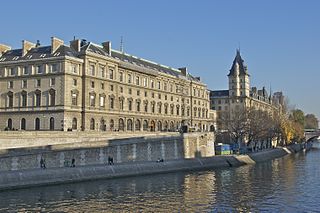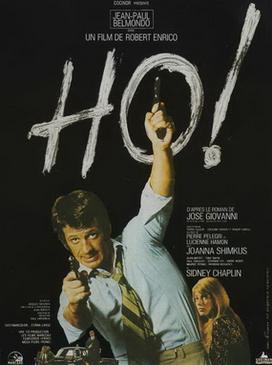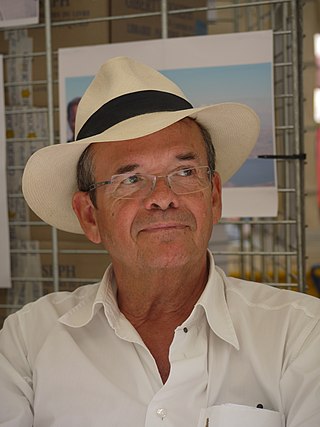
The Bonnot Gang or The Tragic Bandits was a French criminal anarchist group that operated in France and Belgium during the late Belle Époque, from 1911 to 1912. Composed of individuals who identified with the emerging illegalist milieu, the gang used new technology, such as cars and repeating rifles not then available to the police.

Bank robbery is the criminal act of stealing from a bank, specifically while bank employees and customers are subjected to force, violence, or a threat of violence. This refers to robbery of a bank branch or teller, as opposed to other bank-owned property, such as a train, armored car, or (historically) stagecoach. It is a federal crime in the United States.

Henri-Georges Clouzot was a French film director, screenwriter and producer. He is best remembered for his work in the thriller film genre, having directed The Wages of Fear (1953) and Les Diaboliques (1955), which are critically recognized as among the greatest films of the 1950s. He also directed documentary films, including The Mystery of Picasso (1956), which was declared a national treasure by the government of France.

Taxi is a 2004 action comedy film directed by Tim Story and starring Queen Latifah, Jimmy Fallon, Gisele Bündchen in her film debut, Jennifer Esposito, and Ann-Margret. An incompetent New York City police officer is banned from driving and comes to rely on a talented taxi driver to help him solve a series of bank robberies. The film is a remake of the 1998 French film of the same name and was panned by critics.

Michel Paul Fourniret was a French serial killer who confessed to killing 12 people in France and Belgium between 1987 and 2003. After he was arrested in June 2003 for the attempted kidnapping of a teenage girl in Ciney, Fourniret confessed in 2004 to killing nine people, eight females and one male, having been informed on by his then-wife, Monique Pierrette Olivier. Fourniret was convicted of seven of these murders on 28 May 2008 and sentenced to life imprisonment without possibility of parole, while Olivier was given life with a minimum term of 28 years for complicity.

A Search and Intervention Brigade, Investigation and Intervention Brigade or Anti-Gang Brigade) is a unit of the French National Police. The first units were formed in 1964 and carried out their tasks under the command of the Paris prefecture.
Quai des Orfèvres is a 1947 French police procedural drama film based on the book Légitime défense by Stanislas-Andre Steeman. Directed by Henri-Georges Clouzot the film stars Suzy Delair as Jenny Lamour, Bernard Blier as Maurice Martineau, Louis Jouvet as Inspector Antoine and Simone Renant as Dora.

Le Doulos is a 1962 French crime film written and directed by Jean-Pierre Melville, adapted from the novel of the same name by Pierre Lesou. It was released theatrically as The Finger Man in the English-speaking world, but all video and DVD releases have used the French title. Intertitles at the beginning of the film explain that the French title refers both to a kind of hat and to the slang term for a police informant.

The Direction régionale de la police judiciaire de la préfecture de police de Paris, often called the 36 quai des Orfèvres or simply the 36 (trente-six) by the address of its headquarters, is the seat of the Paris regional division of the Central Directorate of the Judicial Police. Its 2,200 officers investigate about 15,000 crimes and offences a year.

36 Quai des Orfèvres is a 2004 French film directed by Olivier Marchal and starring Daniel Auteuil and Gérard Depardieu. The title derives from the original address of the Judicial Police headquarters, part of the larger Palais de Justice of Paris on the Île de la Cité. The film takes place in Paris, where two cops are competing for the vacant seat of chief of the Paris Criminal police while involved in a search for a gang of violent thieves. The film is directed by Olivier Marchal, a former police officer who spent 12 years in the French police. The story is loosely inspired from real events which occurred during the 1980s in France. The film was nominated for eight César Awards. The movie was remade in South Korea in 2019 as The Beast.
Élisabeth Fanger is the French author of J'avais dix-huit ans, an autobiographical account of her adventures following her bank-robber boyfriend Sid Mohamed Badaoui on the run from Paris. The trip would lead them to Spain, Morocco, and eventually Greece. Fanger's novel was made into the 2004 Benoît Jacquot film À tout de suite.

Francis Renaud is a French film and television actor.

Les Fugitifs is a French 1986 action comedy film, directed by Francis Veber. It was remade in 1989 as Three Fugitives, also directed by Veber.
Organized crime in France is primarily based in major cities like Marseille, Grenoble, Paris, and Lyon. It is often referred to as grand banditisme in France.

Ho! is a 1968 French-Italian crime film directed by Robert Enrico and starring Jean-Paul Belmondo. It is based on the 1964 novel Ho! by José Giovanni.
André Hornez was a French lyricist and screenwriter.
Éric Deschodt is a French journalist, writer and translator. He wrote police novels written in collaboration under the pseudonym Bernard-Paul Lallier.

Michel de Roy was a French writer.
The Havelock Bank Robbery was a 1961 armed robbery of bank bonds plus $230,000 cash from the Toronto-Dominion Bank branch in Havelock, Ontario.












